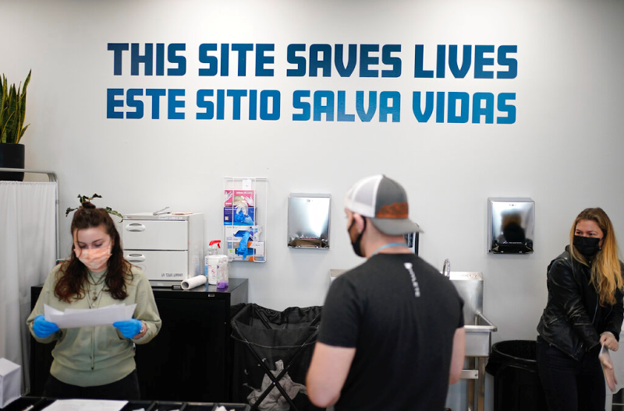130 people a day die from opioid-related drug overdoses in the US, ten times the number in 1999. The opioid epidemic is a crisis that has plagued Americans for decades, taking hundreds of thousands of lives. The United States fervently seeks a solution, yet many Americans in favor of addiction harm reduction argue that the federal government has not done enough to combat the issue. There are still countless policies in place which withhold federal funding from safe drug consumption sites. Because of the government’s negligence, nonprofit organizations and local jurisdictions have begun to establish safe drug consumption sites without federal assistance or funding.
These sites aim to decrease overdose and disease while promoting rehabilitation—a place where people can administer drugs in a secure environment under the supervision of trained personnel. The sites provide clean injection materials, medical supervision, and blood testing available to diagnose and treat bloodborne diseases that spread primarily through sharing needles, such as HIV and Hepatitis B.
These sites decrease HIV infections through clean needle exchanges, testing, and other services. Patients are trained on how to avoid, spot, and respond to drug overdoses with naloxone (narcan), a lifesaving drug provided by SSPs which temporarily reverses the effects of an opioid overdose.
At safe injection sites, those ‘using’ can test their drugs for fentanyl and other deadly compounds often laced into street drugs. Many patients entering these spaces are ill and stuck deep in their addiction, yet are continually met with the primary care and rehabilitation services necessary to begin their journey to recovery.
Legal Support and Federal Barriers
Contrary to popular belief, Syringe Service patients are five times more likely to enter treatment than those who don’t participate in the programs. They are also three times more likely to stop drug use altogether. The CDC reports on the efficiency of Syringe Service Programs (SSPs) by sharing that comprehensive SSPs are “safe, effective, and cost-saving” and can reduce the transmission of viral hepatitis, HIV and other infections. SSPs have lowered overdose mortality by 34.7% and 67% fewer ambulance calls for treating overdoses in their surrounding community. The sites are run by trained professionals who not only aim to prevent deaths and provide addiction treatment, but regard their patients as patients rather than delinquents, instilling a sense of trust in the community.
New York City established America’s first two safe drug consumption sites in Washington Heights and East Harlem in November 2021. Revolutionary, unfamiliar, and widely debated, these spaces prevented over 100 overdoses within a few months. By January 2022, 585 people had registered and used the locations almost 5,000 times. Run by nonprofits, these sites rely on city funding and donations but don’t amass nearly as much as they need or that the federal government could provide.
US drug laws make it extremely difficult to open these sites because it’s a felony to possess illegal drugs. While the Biden administration has vocalized support for this harm reduction method, it has not federally endorsed safe injection sites, making it increasingly difficult for them to keep their doors open.
Fear Mongering, Myths, and Misconceptions
Arguments against these sites’ implementations often include claims of increased drug use, crime in the area, and large operational expenses.
But these claims are nothing but fear mongering. American cities with increasing SSP locations do not experience increases in illegal drug use or crime. According to the CDC, studies in Baltimore and New York City report no significant increase in crime rates throughout neighborhoods surrounding SSPs. While increased illegal activity surrounding the sites is a justifiable concern, it’s critical to understand SSPs’ role in taking these crimes off the street. Illicit drug administration is inevitable; drug consumption will happen with or without these sites. Crimes associated with administering opioids proves constant; with SSPs, however, dangerous drugs and their victims are taken off the street and into a professional setting, making for safer communities.
30 years of research confirms SSPs are cost efficient and effective in reducing bloodborne infections such as viral Hepatitis and HIV. A report by the National Library of Medicine evaluates the cost of treating infective endocarditis, a major complication caused by opioid injection, emphasizing the importance of addiction treatment capabilities. The report notes that the most effective way to save money when treating endocarditis is to invest in proactive measures.
By providing proactive and reactive resources such as clean needles and diagnoses, safe drug consumption sites save millions of dollars that would otherwise be spent on hospital diagnoses and treatments.
The government’s response to the opioid epidemic bears a striking resemblance to its response to the HIV/AIDS epidemic in the 1980s and ’90s. Initially overrun by taboos stemming from stereotypes about homosexuality and gay sex, the government ignored the AIDS epidemic for years. Once the US finally funded research and improved public education about the illness, the epidemic subsided. The HIV/AIDS crisis shows that advocacy and education are vital for improvement regardless of social implications.
In the past decade, the nation has seen massive increases in reports of HIV and other bloodborne diseases due to needle sharing and lack of diagnostic screenings. On top of this, the social stigma surrounding the disease has discouraged patients from seeking treatment or testing. HIV.gov reports 7% of all 2021 HIV diagnoses in the US are people who inject drugs. We must advocate for those who have fallen victim to an epidemic that has spun out of control. It’s time for policymakers to get past taboos and biases and to prioritize harm reduction strategies that will decrease deaths and other opioid dangers.



